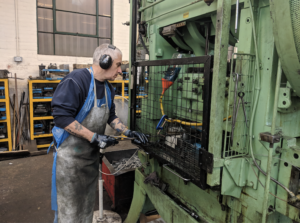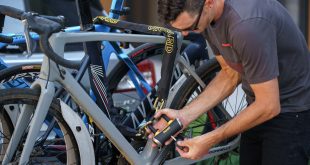Rebecca Morley takes a tour of the Brooks factory in Smethwick to find out about the brand’s heritage and what goes into making its famous saddles
Brooks England has a rich heritage of making premium saddles – one that dates back to the 19th century. JB Brook filed his first saddle patent back in 1882, and JB Brooks & Co registered as a public limited company is 1896. It has been in its current factory, based in Smethwick, since 1962, making its saddles with incredible skills and precision alongside years of experience.

The 27,000 square feet factory has approximately 140 machines in total, creating a loud and busy environment. Some of the machines date back to the early 1950s, in particular, the metal-working machines that bend saddle rails and create springs. Walking around, I saw some saddle moulds that displayed the dates they had been made – one was April 1956 and another was 1961.
Hamish Bingley, brand manager from Brooks, explains why Brooks still uses slightly older machinery: “This is a testament to the high-quality machinery that is used to produce the finest saddles. In keeping with the brand’s ethos of products being built to last many years, so too are some of the machines that make them! Why replace them if they’re still working well?”
Brooks’ original factory was in central Birmingham, part of the Brooks family for two generations, then moved to present Smethwick site in 1962 once sold by the second generation of the Brooks family. In terms of recent growth, the business has more than doubled in size since being acquired by Selle Royal in July 2002.
Having a factory in the UK is significant for Brooks too. Bingley says: “Aside from the obvious point of creating manufacturing employment for UK-based employees, Brooks’ UK heritage and manufacturing is very much integral to how consumers perceive the brand. It is, after all, a very ‘British’ brand.
“‘Made in the UK’ resonates well with Brooks’ customers, be they from the UK itself, the USA or Japan. When viewed internationally the UK brand reinforces perceptions of high quality, distinction and fine craftsmanship. These characteristics rub off well on the Brooks brand. The adage of ‘you get what you pay for’ springs to mind.”
Leather production continues unabated in Smethwick too. The brand uses thick leather, I was told, which generally comes a cow’s back. The shoulder is too thin for the brand to use, so all the soft leather goods, such as handbags, tend to come from the shoulders or the belly.
The craftsmanship that goes into making a saddle was evident. Each individual has a ‘signature’ way of hammering copper rivets, in such a way that they can tell who did each one just by looking at it.
Brand heritage
John Boultbee Brooks was born in Hinckley, Leicestershire on 22 April 1846, and in 1866 he arrived in Birmingham with £20 in his pocket and established J.B. Brooks & Co, a company manufacturing leather harness and tackle for horses. In 1878 the death of his horse prompted him to try a new-fangled bicycle. According to the brand, he found the saddle so ‘excruciating’ that he vowed to make a more comfortable one, and the first Brooks saddle prototype was born.
Bingley explains the brand’s heritage and why it’s been so successful: “At the heart, it’s an innovative company. Once Mr Brooks’ horse had died and he had instead started to use the bicycle as a means of transport, he was horrified by how sore he found his machined-wood saddle (the norm back then) to be.

“This is when he decided to explore the use of leather in saddle manufacturing. The concept of breaking-in the leather and thereby moulding the saddle over time to the exact shape of the rider was what quickly established the Brooks saddle brand for its superior rider comfort.
“‘Riding a Brooks’ became synonymous with tailored saddle comfort on a bicycle. Brooks’ leather saddles were used by top-flight racers up until the early 1970s. Even then, it was only due to the emergence of lighter weight materials, as opposed to superior comfort, that other saddles began to gain popularity among the pro peloton.
“Ever since its inception, Brooks has continually sought to use the highest quality leather, superior manufacturing techniques and best hand-made craftsmanship to produce the finest saddles in the world. In recent years, it has launched the innovative Cambium range of saddles: tailored saddle comfort, but this time using organic rubber and canvas instead of leather.
“Brooks was, in fact, the first saddle brand to file a patent for a saddle with a ‘hole’ or ‘cut-out’ to relieve pressure on the perineum. It did this back in the 1880s! This lead the brand to introduce the Brooks ‘Imperial’ leather saddles that remain in the range to this day.”
So what’s new for 2019? Bingley says the Cambium C13 has been given the ‘All Weather’ cover treatment, and the Cambium Organic Light has been launched for Brooks Premium Dealers only. This new, more environmentally conscious saddle contains a backplate made from Liquid Wood which will biodegrade once buried in the soil for five years.
The popular Cambium comfort grips are now available in black, and the Pickwick Leather and Pickwick Leather Reflective bag ranges for Brooks Premium Dealers only round off the 2019 launches.
The Cambium range
Brooks England has been unrivalled in producing comfortable, stylish leather saddles for well over a century. In a constantly evolving marketplace, it is vital to remain unique and to genuinely strive to keep research and development at the forefront of the product line, and the brand says it has achieved this with the Cambium range.
The Cambium’s vulcanised natural rubber and organic cotton top offer comfort and freedom of movement essential to the performance and endurance racer. The entire surface of the Cambium top moves and flows naturally with the movement of the rider for better pedalling and control.
The hard-wearing top, die-cast aluminium structure, and tubular steel rails allow the Cambium to stand up to many years of hard use, and a distinct dampening effect is delivered by the classic Brooks ‘hammock’ construction, reducing road vibrations and keeping the rider comfortable in the saddle.
Brooks says the key functions of the Cambium include immediate comfort, a maintenance-free and weatherproof design, combined with the style and longevity for which the brand is famous, appeal to passionate Brooks stalwarts along with a far-reaching cycling genre, from commuters and winter training roadies to mountain bike and cyclocross riders looking for the most comfortable saddle available.

Replaceable hardware extends practicality for riders travelling to remote places, and whilst the Cambium will not mould to your form like the leather option, the hammock shape and flexibility is still firmly in place, the brand says. Bingley says that in terms of best-selling products, the classic leather B17 in all three colours is proving as ‘popular as ever’, and the Cambium All Weather C17 Carved and C17 models aren’t far behind.
As a partner to the saddle and accessory ranges, Brooks has an extensive range of luggage products, from the stylish Transit line, with models such as the Pickwick Rucksack and Barbican Messenger, to the Utility line, which features 2000mm Bluesign waterproof fabric. The brand has been manufacturing bags since the late 19th century and continues to adapt and develop the range to suit the modern cyclist.
BPD Programme
Brooks says it wishes to complement its outstanding design and distinctive quality by moving gradually towards a selective distribution model that consolidates its position as a premium brand in the bicycle industry.
This new programme, named the Brooks Premium Dealer Programme, is dedicated to all brick and mortar bicycle retailers, it says, and most importantly integrates product, communication and trade marketing.
Following a phased three-year implementation process, participation in the programme will become a necessary condition to sell Brooks products. There are three levels of dealer: Select, Distinct and Standard. Each will receive various benefits according to their level.
Select and Distinct dealers will have access to products that are exclusive to them – limited editions, custom products, exclusive lines and categories. There will also be product training from Brooks staff, bolstered by specific marketing and sales support resulting from regular contact with the brand. Dealers registered for the programme will receive an official BPD plate, which will be updated every year with their current level. A detailed shop listing will be included on the Brooks website dealer locator.
From 2019 onwards, top-tier dealers will also benefit from a special modular display. This way, Brooks products will be presented in a consistent brand environment to maximise in-store sales potential. Due to the display’s modularity, it is flexible enough to meet the individual requirements of most shops. They can be either free-standing or mounted to the wall. Modules of these displays will also be made available to Distinct dealers from 2020.
2019 is the first year of the roll-out of the programme, primarily focussed on providing new benefits for Select and Distinct dealers. New product development work continues apace at Brooks, but nowadays with one major difference: always with a view to which products/ lines/ ranges will be BPD-exclusive once launched, the brand says.
Brick and mortar shops have enabled Brooks to deliver its fine, hand-crafted products to consumers ever since the brand started producing saddles 153 years ago. Today, Brooks has said it looks forward to continuing this successful partnership with renewed vigour over the coming months and years with its Premium Dealer Programme.
Bingley says: “Brooks is working more and more closely with its authorised network of committed bricks and mortar IBDs because they are simply instrumental in delivering an excellent Brooks purchase experience to consumers.
“As a premium brand in the cycling industry, Brooks consumers should expect nothing less. Brooks’ high-quality hand-made cycling products are best-experienced and understood by the consumer when seen, touched and smelt in a shop.

“No one else, other than brick and mortar retailers, are better placed to identify the correct saddle for a consumer’s specific needs, explain the details of how to break in and maintain a leather saddle, and convey the true sense of craftsmanship that goes into each product’s creation.
“For example the authentic smell of leather, the skill required to ensure a clean chamfered edge to the special leather saddles, and each craftsman’s individual ‘signature’ way of hammering copper rivets are all finer details that a dealer can show the consumer, in turn adding value to their experience.
“Together with a Brooks Premium Dealer’s natural passion to sell the best product, only they will have received the necessary product training from Brooks, married with a clear product display to ensure the best experience for the consumer.
“Everyone stands to benefit from this new programme: Brooks Premium Dealers will sell more because their proposition to the consumer is enhanced (with specific product and brand knowledge, and exclusive products), consumers will be pleased because they will receive information and can buy products that they can’t find elsewhere, and finally Brooks reinforces its premium brand positioning by partnering only with bricks and mortar IBDs that are committed to delivering the best Brooks customer service experience to the consumer.”
 BikeBiz Bicycle and cycling retail news
BikeBiz Bicycle and cycling retail news




